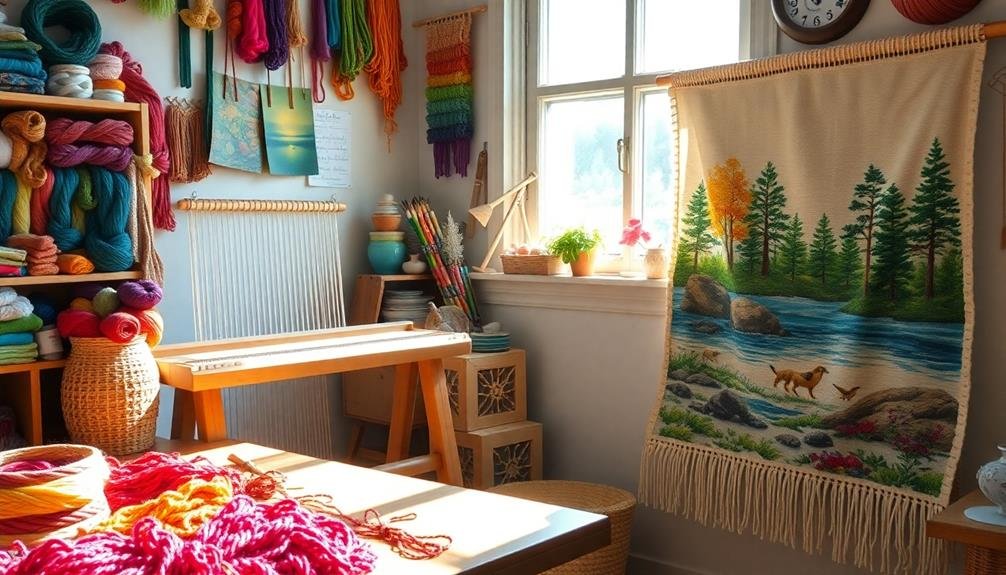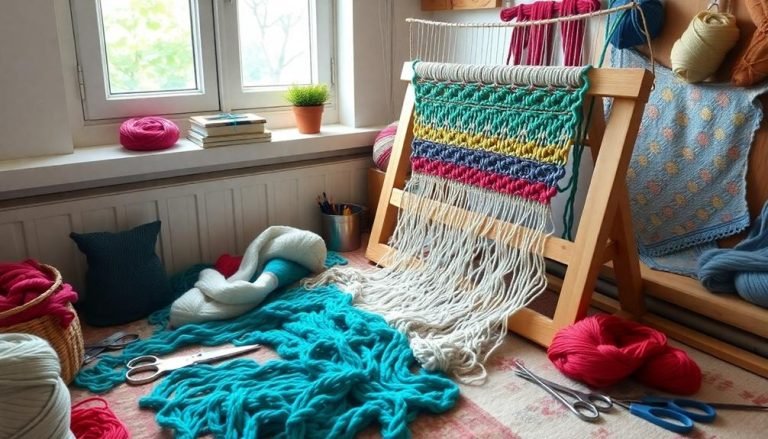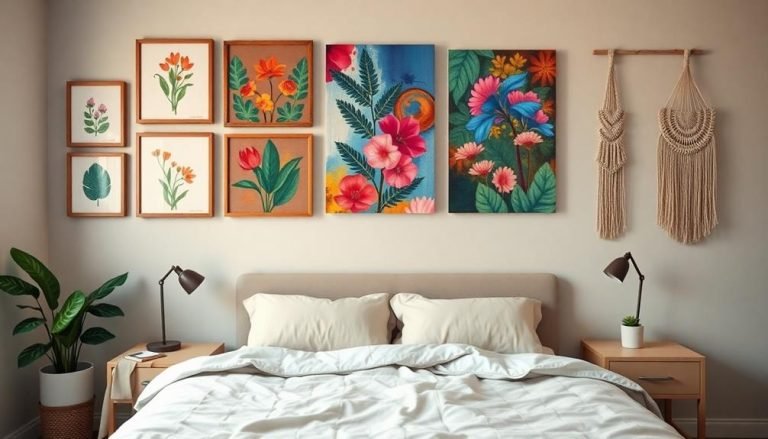Creating a tapestry is like weaving a story with threads as your words. You might think it's a complex task, but it can be simplified into just three manageable steps. First, you'll need to gather the right materials, ensuring you have everything at hand. Next, the design you choose will shape your narrative, reflecting your personal style and vision. But how do you bring all these elements together to create a piece that truly resonates? The answer lies in the weaving process, where your creativity can flourish.
Key Elements
- Gather essential materials: a sturdy frame, yarn or thread, a tapestry needle, scissors, and a measuring tape or ruler.
- Choose a design that resonates with you, considering themes like nature, abstract, or personal stories.
- Prepare your loom and securely set up threads based on your chosen design.
- Use the "over-and-under" weaving technique while maintaining even thread tension for a sturdy tapestry.
- Embrace the process, periodically checking alignment with your original design for a cohesive final piece.
Gather Your Materials
Before diving into your tapestry project, you'll need to gather all the necessary materials. Start with a sturdy frame, as this will provide the foundation for your weaving. Choose one that accommodates the size of your desired tapestry; a larger frame offers more flexibility but requires more skill.
Next, select the yarn or thread that you'll be using; consider a range of colors that resonate with your chosen aesthetic. Wool is a popular choice for its durability and warmth, while cotton offers a softer, more delicate finish.
You'll also need a tapestry needle, which is larger than standard sewing needles, allowing for easy threading of thicker yarns. Scissors are essential for trimming your threads, ensuring a clean edge and polished look.
Don't forget a measuring tape or ruler to keep your project consistent, along with a sketchbook for jotting down ideas and concepts.
Choose a Design
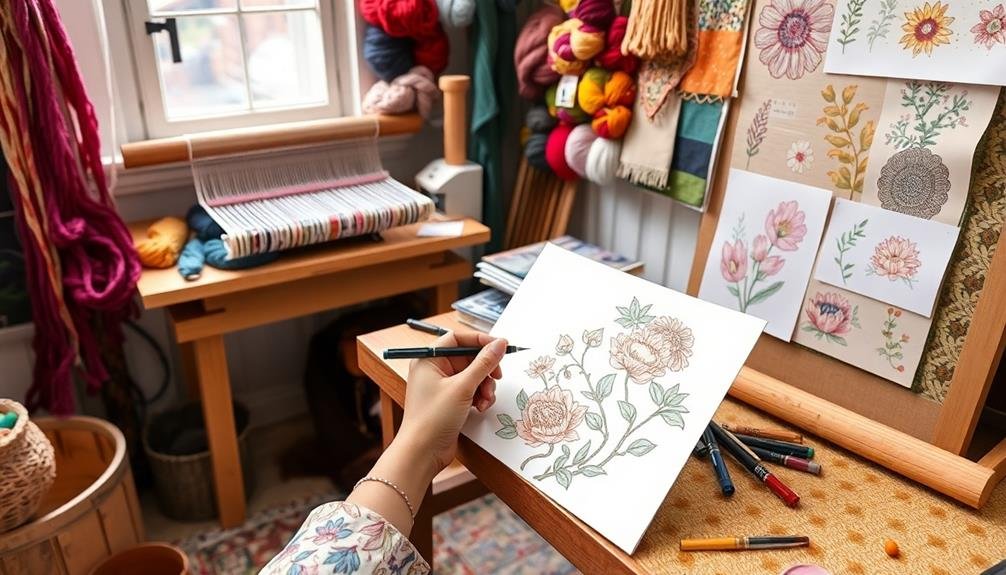
Choosing a design is essential to the success and enjoyment of your tapestry project. Your design sets the tone, theme, and emotional resonance of your work, so it's worth investing time to select something that truly speaks to you. Consider elements like color schemes, patterns, and motifs that resonate with your personal experiences or cultural heritage.
Here's a simple table to help you brainstorm ideas:
| Theme | Color Palette | Motif |
|---|---|---|
| Nature | Earth tones | Leaves and trees |
| Abstract | Bright, contrasting | Geometric shapes |
| Personal Story | Warm, inviting hues | Symbols from your life |
Each theme offers a unique opportunity for expression, whether you want to evoke tranquility, energy, or nostalgia. When choosing your design, make certain it reflects your journey and fosters a connection with others who appreciate your artistry. Remember, this tapestry isn't just about creating art; it's about weaving your story into a piece that can resonate with anyone who sees it. By carefully selecting a design, you're not only crafting a tapestry but also inviting others into your narrative.
Weave Your Tapestry
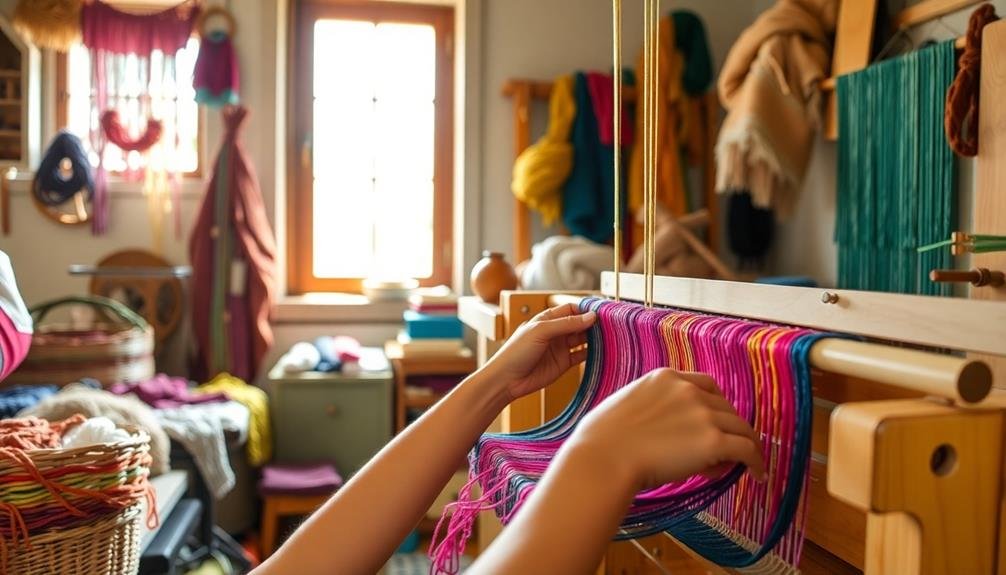
With your design in hand, it's time to bring your tapestry to life through weaving. Begin by preparing your loom, ensuring it's securely set up to accommodate the threads you'll be using.
Select your yarns based on color, texture, and material, as these choices will greatly impact the overall appearance of your tapestry. As you start weaving, use a technique known as "over-and-under," where each strand of yarn alternates its position with the previous row, creating a sturdy fabric.
Pay close attention to the tension of your threads; too tight, and your tapestry may become distorted, too loose, and it may sag. As you progress, periodically step back to assess your work, ensuring it's aligning with your original design.
Remember, weaving is a meditative process, so embrace the rhythm and repetition, allowing yourself to become engrossed in the craft.
Once you've completed the weaving, finish by securing the ends of your yarns to prevent unraveling.
Frequently Asked Questions
How Long Does It Typically Take to Complete a Tapestry?
It typically takes anywhere from a few weeks to several months to complete a tapestry, depending on its size and complexity. You'll enjoy the journey, creating something beautiful and unique that reflects your style.
Can I Use Recycled Materials for My Tapestry?
Absolutely, you can use recycled materials for your tapestry! It not only adds unique textures and colors but also helps the environment. Embrace your creativity and let your tapestry tell a sustainable story.
What Tools Are Essential for Beginners in Tapestry Weaving?
For beginners in tapestry weaving, you'll need a loom, yarn, a tapestry needle, and scissors. Having a good tapestry comb or fork can also help. These tools will make your creative journey smoother and more enjoyable!
How Do I Care for My Finished Tapestry?
To care for your finished tapestry, gently vacuum it with a soft brush attachment, keep it away from direct sunlight, and store it flat or rolled to prevent creasing. You've created something beautiful; cherish it!
Where Can I Display My Tapestry After It's Finished?
After you've finished your tapestry, consider showcasing it in your living room, entryway, or bedroom. Hanging it on a wall or draping it over furniture creates warmth and invites connection with anyone who visits.
Whats Next
In summary, by meticulously gathering your materials, thoughtfully choosing a design, and skillfully weaving your tapestry, you initiate a creative journey that transcends mere craft. Picture yourself, surrounded by a kaleidoscope of colors and textures, as each thread becomes a vibrant story woven into existence. Your tapestry, a proof of your artistic vision, will not only adorn your space but also serve as a timeless narrative, capturing moments and memories that resonate for generations to come.

